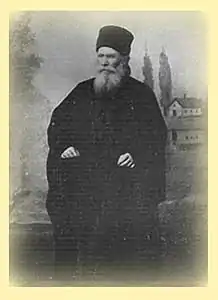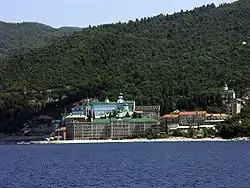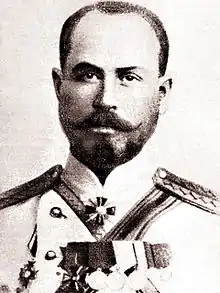Imiaslavie
Imiaslavie (Russian: Имяславие, literally "praising the name") or Imiabozhie (Имябожие), also spelled imyaslavie and imyabozhie, and also referred to as onomatodoxy, is a dogmatic movement which asserts that the Name of God is God Himself. Although it was condemned by the Russian Orthodox Church in 1913,[note 1] it is still promoted by many contemporary Russian writers. Many contemporary supporters are affiliated with Bishop Grégory Lourie and St. Sergius Orthodox Theological Institute in Paris. The movement emerged in the beginning of the 20th century but both proponents and opponents claim it to be connected with much religious thought throughout the history of Christianity (proponents claim its connections to the Church Fathers, while opponents claim the connections to the ancient heresiarchs).
Beginning

The 20th century history of Imiaslavie started in 1907 with the publication of the book On the Caucasus Mountains by a revered starets, Schema-monk Hilarion. In his book, Hilarion told of his spiritual experience with the Jesus Prayer as a proof that "The name of God is God Himself and can produce miracles". The book became extremely popular among the Russian monks on Mount Athos in Greece. Many of them argued that, since according to Plato, "the name of an object exists since before the object itself does" , so the name of God must pre-exist before the world was created, and that it (the Name) cannot be anything but God Himself. Among other things, this was thought to mean that knowledge of the secret name of God alone allows one to perform miracles (a similar concept exists in Kabbalah). This also implied that extreme caution was needed when using names like Jehovah, Christ, etc.
The opponents of Imiaslavie, the other Athonite monks, considered this teaching to be pantheism and incompatible with Christianity. They argued that, before the Creation God did not need this name, so the name was created and is actually an empty sound having no mystical attributes in and of itself. The proponents of the former idea got the name Imyaslavtsy (those who glorify the Name) and its opponents were called Imyabortsy (those who fight the Name).
Proponents and opponents
The main proponent of the Imiaslavie doctrine was a Hieromonk of the Andreyevsky skete of Athos Mountain, Anthony Bulatovich, who published a few books on the subject. Those who promote this doctrine claim support from the writings of Saint John of Kronstadt, and the influential mystic and healer Grigori Rasputin, the popularly styled "mad monk" who was closely associated with the Russian Royal Family shortly before the October Revolution. St John of Kronstadt died before this controversy erupted, and his quotes, it can be argued, are taken out of context to support a whole set of ideas that are not found in his own writings.[note 2] One of the most precise definitions of the Imiaslavie position comes from its advocate Aleksei Losev who writes that Imiaslavie is to be understood as “mystical formula”: “... the exact mystical formula of Imiaslavie will sound like this: a) the name of God is energy of God, inseparable from the essence of God itself, and therefore is God himself. b) However, God is distinct from His energies and from His name, and that is why God is not His name or a name in general...”[3] While the controversy never erupted within Catholicism, the Catechism of the Catholic Church in paragraphs 2666-2669 clearly teaches that “The name ‘Jesus’ contains all”.[4]
The most vocal opponent was the archbishop of Volyn, Anthony (Khrapovitsky), who considered imiaslavie to be a variation of the heresy propounded by the Khlysts (khlystovschina). In 1912, by decision of the Holy Synod, the book On the Caucasus Mountains became forbidden in Russia. It was not reprinted until 1998. In September 1912 the book was judged by Patriarch Joachim III of Constantinople, who gave a negative opinion about it (though in 1907 he had supported the same book).
In January 1913 a monk called David, a supporter of imiaslavie, was elected as the hegumen of the Andreyevsky skete, taking the place of the monk Hieronim who was an opponent of it. Hieronim did not recognize the results of the elections and complained to the Russian Embassy in Greece. The Imperial Government insisted on changing the hegumen back to Hieronim. In April the teaching of imiaslavie was also proclaimed to be pantheism by the new Patriarch Germanus V of Constantinople.
Storming the monastery

In June 1913 a small Russian fleet, consisting of the gunboat Donets and the transport ships Tsar and Kherson, delivered the archbishop of Vologda, Nikon (Rozhdestvensky), and a number of troops to Mount Athos. The poll organized by the archbishop had shown that among 1700 of St. Panteleimon Monastery's monks, 661 monks identified themselves as imiabortsy, 517 as imiaslavtsy, 360 refused to participate in the poll, and the rest identified themselves as neutral. In May and June archbishop Nikon held talks with the imiaslavtsy and tried to convince them to change their beliefs voluntarily, but was unsuccessful. On 31 July, the troops stormed the monastery. Although the monks were not armed and did not actively resist, the troops showed very heavy-handed tactics. They set up two machine guns and a number of water cannons, and the soldiers were ordered to beat the monks with their bayonets and rifle butts. Allegedly, four monks were killed and at least forty-eight were wounded. After the storming of St. Panteleimon Monastery the monks from the Andreevsky Skete surrendered voluntarily.
The military transport Kherson was converted into a prison ship. It took 628 monks to Russia and on 9 July set sail to Odessa. Forty monks were left in the Mt. Athos hospital, judged unable to survive the transportation. On 14 July, the steamship Chikhachev delivered another 212 monks from Mt. Athos. The rest of the monks signed papers that they rejected the imiaslavie.
After interrogation in Odessa, 8 imprisoned monks were returned to Athos, 40 put into jail, and the rest were defrocked and exiled to different areas of the Russian Empire according to their propiska. One of the leaders of the imiaslavtsy, Antony Bulatovich, was sent to his family estate in the village Lebedinka of Kharkiv gubernia, to where many imiaslavtsy moved.
Aftermath

In February 1914 some imiaslavtsy were received by the Emperor Nicholas II. The kind reception was considered a sign of changing fate. In May 1914, Makariy, the Metropolitan of Moscow, and the Moscow Synodal Office decided to accept the imiaslavtsy into church services without their having to repent, as "there was nothing to repent about." A similar decision was taken by the Kiev Metropolitan. On May 10 the decision was partially adopted by the Holy Synod that the imiaslavtsy were allowed to keep their positions in the Orthodox Church without a formal repentance, but it specified that the teaching itself was still to be considered a heresy.
On 27 August 1914 the leader of the movement Anthony Bulatovich asked to be sent as an Army chaplain to World War I, his request was granted by the Holy Synod. On 1 July 1915, the Holy Synod received a letter from the original author, schema-monk Illarion, asking whether he was expelled from the Church (Illarion lived as a hermit in the Caucasus Mountains and seems to have been unaware of all the commotion his book caused). Illarion died on 2 June 1916, without having received an answer. In September 1917 the Pomestny Sobor of the Russian Orthodox Church was assembled to solve the problem with Imiaslavie, with both strong proponents and opponents of Imiaslavie present. The work of the Sobor was aborted due to the October Revolution. Among the theologians who spoke out for Imiaslavie were Pavel Florensky and Sergey Bulgakov.
In October 1918 the Holy Synod of the Russian Orthodox Church cancelled the previous decision, and no longer allowed imiaslavtsy to participate in church services unless they repented. The decision was signed by Patriarch Tikhon of Moscow. In January 1919 the leader of the imiaslavtsy, Antony Bulatovich, broke relations with the Holy Synod and Tikhon and returned to his family estate in Lebedinka. There, he was killed either by robbers or by soldiers of the Red Army in December.
The question of compatibility between Orthodoxy and imiaslavie is still hotly argued by some theologians. Among those who have promoted Imiaslavie, Sergius Bulgakov must be mentioned. Perhaps the most precise articulation of Onomatodox Orthodox theology is that given by Aleksei Losev who explains that Imiaslavie has devised this “mystical formula,” which needs to be spelled out: “... the exact mystical formula of Imiaslavie will sound like this: a) the name of God is energy of God, inseparable from the essence of God itself, and therefore is God himself. b) However, God is distinct from His energies and from His name, and that is why God is not His name or a name in general...”
Bishop Hilarion (Alfeyev), in 1999, wrote: "Even though the movement of the 'Name-worshippers' was crushed at the beginning of the century on the orders of the Holy Synod, discussion of the matter regained impetus in the years preceding the Moscow Council (1917–18), which was supposed to come to a decision about this but did not succeed in doing so. Thus the Church's final assessment of Name-worshipping remains an open question to this day." [5]
Those apostolic churches which consider themselves to be Eastern Orthodox and who are officially pro-imiaslavie include Holy Orthodox Church in North America and St. Elizebet Church in St. Petersburg, Russia.[6] The Russian True Orthodox Church - Metropolia of Moscow considers imiaslavie to be an acceptable theologoumenon. An apostolic church which considers itself Primitive Catholic that is pro-imiaslavie is the Libera Catholick Union.[7] According to their spokesperson and the group’s Facebook description, a spiritual order that is part of the New Monasticism movement and publicly pro-imiaslavie is the Brood of Holy Wisdom, a re-formation of the former Society of Saint Sophia, which had been headed by the famous pro-imiaslavie Russian Orthodox priest and theologian, Fr. Sergei Bulgakov.
Imiaslavie and mathematics
The Russian Mathematics School is considered by some to have been created by Dmitri Egorov and Nikolai Luzin, both of whom were Imiaslavtsy and personal friends of Pavel Florensky as well as philosopher Aleksei Losev (both imiaslavtsy in theology).[8][9] Florensky was a pupil of Egorov and a classmate of Luzin, and they published together. Florensky published works on the parallels between abstract mathematics and religion: he stated that the mathematics of continuous functions is like rationalism while some concepts, such as transfinite numbers, can be explained only in the framework of the Imiaslavie philosophy, where the Name of God is God Himself.
The historians of mathematics Loren Graham and Jean-Michel Kantor have stated that the work of the Russian Mathematics School is still filled with this mysticism while the French Mathematics School is considered to be based on rationalism.
Notes
- In 1912, a Council of Constantinople was convened and presided over by Ecumenical Patriarch Joachim III, and attended by several bishops, condemning the "Onomatodoxi"/"Imiaslavie" (name-worshippers), who believed that the name of God is God Himself.[1] A second council was held in 1913 and third by the Russians, also in 1913. http://onimyaslavie.blogspot.com/search/label/Imiaslavie
- Vladimir Moss observes:
As another example of how the name-worshippers distort the holy fathers, let us consider their oft-repeated claim that St John of Kronstadt believed that the Name of God was God. Now it is quite true that St John sometimes employed expressions which, taken out of context, might lead one to believe that he was a name-worshipper. But the context was always prayer; and the point St John was always trying to make was that in true, heartfelt prayer, no distinction is felt between God and the Name of God (and this, as we have seen, is perfectly true). But that St. John did not confuse the subjective identification of "Jesus" and Jesus in prayer with their objective identification in reality is evident from the following: "Let not the heart weak in faith think that the cross or the name of Christ act of themselves, or that this cross and this name of Christ produces miracles when I do not look with the eyes of my heart or with the faith of Christ".[105] These words of St John contradict one of the main theses of name-worshipping, namely, that the name of God, being God Himself, works of itself.[2]
References
- The Genuine Orthodox Church of Greece. Genuine Orthodox Church of the 20th and 21st Centuries - A Timeline. Retrieved 2 February 2013.
- Vladimir Moss. The Name Of God And The Name-Worshipping Heresy. 2 April 2007.
- Dn. Lasha Tchantouridzé, “In the Name of God: 100 Years of the Imiaslavie Movement in the Church of Russia”; The Canadian Journal of Orthodox Christianity Volume VII, Number 3, Fall 2012; p. 225.
- Bishop Hilarion Alfeyev. "Orthodox Theology on the Threshold of the Twenty-First Century:- Theology and Spirituality:- Articles in Englishpublisher=Orthodox Europe (organisation)".
- "Храм Св. Елисаветы в Санкт-Петербурге" (in Russian). Retrieved 2020-06-01.
- "Bulletin, spring 2005: Graham" (PDF). AmAcad. Archived from the original (PDF) on 2007-03-07. Retrieved 2006-05-27.
- "Unknown title". Examen database. Archived from the original on 2007-09-28. Retrieved 2006-05-27.
Further reading
- (in French) Bishop Hilarion Alfeyev, Le Nom grand et glorieux. La vénération du Nom de Dieu et la prière de Jésus dans la tradition orthodoxe. Paris: Cerf, 2007.
- (in French) Bishop Hilarion Alfeyev, Le mystère sacré de l'Eglise. L'introduction à l'histoire et à la problématique des débats athonites sur la vénération du Nom de Dieu. Fribourg: Academic Press, 2007.
- (in Italian) Bishop Hilarion Alfeyev, La gloria del Nome. L’opera dello schimonaco Ilarion e la controversia athonita sul Nome di Dio all’inizio dell XX secolo. Bose: Qiqajon, 2004.
- Daniel Colucciello Barber, Deleuze and the Naming of God (2015), Edinburgh University Press
- Robert Bird, Ph.D., "Imiaslavie and Baroque Spirituality." AAASS Convention, Pittsburgh, PA, 22 November 2002
- Sergius Bulgakov (author), Boris Jakim (translator), Icons and the Name of God (2012), Eerdmans
- (in Russian) Sergius Bulgakov, Philosophy of the Name ("Философия имени", 1920)
- Dr. John Eugene Clay, Arizona State University, "Popular Uses of the Jesus Prayer in Imperial Russia from the Old Believers to the Name-Glorifiers", presentation at AAR, Philadelphia, Pennsylvania, November 2005
- Tom E. Dykstra, Hallowed Be Thy Name: The Name-Glorifying Dispute in the Russian Orthodox Church and on Mt. Athos, 1912-1914, 2014. ISBN 978-1601910301
- Valentina Izmirlieva, All the Names of the Lord: Lists, Mysticism, and Magic (2008), University of Chicago Press
- Scott M. Kenworthy, Ph.D., "Church, State, and Society in Late-Imperial Russia: The Imiaslavie Controversy," presentation at American Association for the Advancement of Slavic Studies National Convention, Pittsburgh, Pennsylvania, November 2002
- Scott M. Kenworthy, Ph.D., "Church, State, and Society in Late-Imperial Russia: Nikon (Rozhdestvenskii) and Imiaslavie," presentation at Midwest Russian Historians Workshop, Miami University, Oxford, Ohio, March 2003
- Michael T. Miller, The Name of God in Jewish Thought: A Philosophical Analysis of Mystical Traditions from Apocalyptic to Kabbalah (2015), Routledge
- Helena Gourko, Divine Onomatology: Naming God in Imyaslavie, Symbolism, and Deconstruction (2005), Ph.D. dissertation at Boston University
External links
- (in Russian)Alexei Losev Imiaslavie
- (in Russian)Alexei Losev Philosophy of a Name
- (in Russian) Metropolitan Veniamin (Fedchenko) Imiaslavie
- (in Russian) Pavel Florensky Brief biography of Starets Illarion and History of Imiaslavie in Russia
- Scott M. Kenworthy, "Archbishop Nikon (Rozhdestvenskii) and Pavel Florenskii on Spiritual Experience, Theology, and the Name-Glorifiers Dispute"
- Scott M. Kenworthy, "Debating the Theology of the Name in Post-Soviet Russia: Metropolitan Ilarion Alfeev and Sergei Khoruzhii"
- (in Russian) Archbishop Nikon (Rozhdestvenskii), "The Crafty designs of the enemy will destroy...": Diaries: 1910-1917 - by active disputant in the controversy with the Imiabozhie
- (in French) Tatiana Sénina (moniale Kassia), Un palamite russe du début du XXème siècle : le hiéromoine Antoine Boulatovitch et sa doctrine sur l’énergie divine, in Scrinium, t. 6: Patrologia Pacifica Secunda (2010) 392-409.
- Vladimir Moss The Name Of God And The Name-Worshipping Heresy
- (in Russian) Of imyaslavtsy or imyabozhniki: Dispute about nature of the name of God and Athos - Extensive discussion
- website of the nun Kassia Senina on Imaslavie
- In the Name of God:100 Years of the Imiaslavie Movement in the Church of Russia
- Monk Hilarion On the Mountains of the Caucasus
- Matthew Raphael Johnson, “‘Name Worship,’ Epistemology and the Abuse of Christian Philosophy: A Revision”
- Matthew Raphael Johnson “The Essence of Words”
- The Holy Orthodox Church in North America, Metropolis of Boston (their administrative center)
- Divergent Teachings: A Synopsis of the Patristic Teaching on the Name of God (a HOCNA Doctrinal Encyclical)
- The Russian True Orthodox Church - Metropolia of Moscow
- Catechism of the Catholic Church 2666
- LDS General Authority “NAME AS ESSENCE OR EXALTATION”